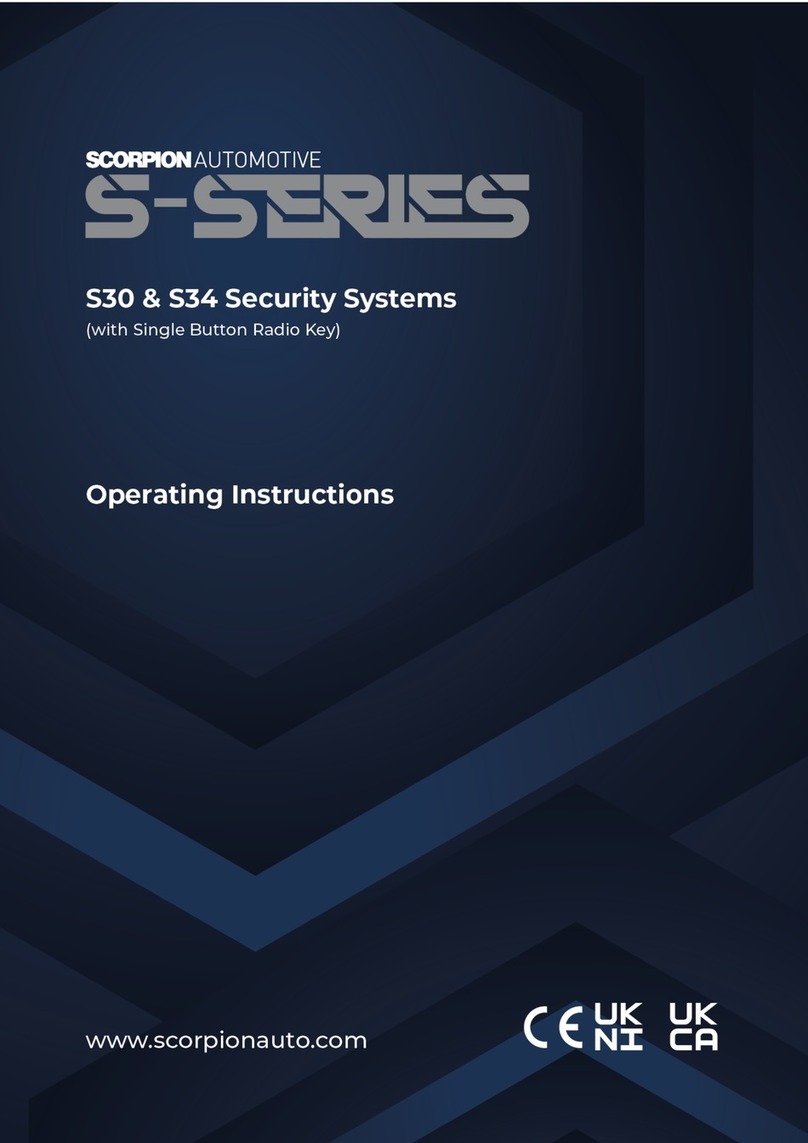
USER MANUAL
The alarm is operated via the vehicle original remote control. The built-in radio receiver allows the
owner to wirelessly control the engine immobilizer from the TAG card.
2.1 – SYSTEM ARMING
Press the lock button on the vehicle original remote control; arming is confirmed by a Beep and a
flash of the turn indicators (if signals are enabled).
NB: Before it is fully armed, the system has a 30 sec. arming delay signaled by the LED ON
steady.
2.2 – SYSTEM ARMING WITH SENSOR AND CONFORT EXCLUSION
To arm the system without internal volumetric protection (US sensors), optional wireless PIR
sensors and comfort feature, proceed as follows:
Make sure the system is disarmed and ignition key is in the OFF position.
Touch the override key to its receptacle; the LED will flash quickly.
Close all vehicle doors and press the lock button on the vehicle original remote control.
System arming is confirmed by a Bop and a flash of the turn indicators (if signals are enabled).
2.3 – PASSIVE ARMING
When passive arming is enabled, the system automatically arms approx. 60 sec. after ignition is
switched OFF and after the last door is opened and closed.
Arming is confirmed by a Beep and a flash of the turn indicators (if signals are enabled).
2.4 – ARMING DELAY
There is a 30 sec. delay from the time the system is armed to allow you to exit the vehicle without
triggering an alarm: it will be signaled by the LED powered ON steady.
2.5 – SYSTEM ARMED
After the arming delay the system is fully armed and ready to detect any alarm event. The LED will
start flashing to confirm the armed status.
2.6 – ALARM, INHIBIT TIME BETWEEN ALARMS AND ALARMCYCLES
Alarm events are signaled by optical/acoustic signals. Each event can generate up to 10 cycles for
each input and for each arming cycle with a pause of 5 sec. between each cycle. One alarm cycle
lasts 30 sec.
2.7 – SYSTEM DISARMING
Press the unlock button on the vehicle original remote control. Disarming is confirmed by 2 Beeps
and 2 flashes of the turn indicators (if signals are enabled).
If an alarm event has occurred while you were away from your vehicle, it will be signaled, when you
disarm the system, by 5 Beeps and 5 flashes of the turn indicators (if signals are enabled). Alarm
causes and relative LED signals are listed in par. 2.10.
PAGE02
1.0 – INTRODUCTORY NOTE………………………………………………………………........PAGE
USER MANUAL
2.0 - OPERATING PROCEDURE........................................................................................PAGE 03
2.1 – System arming…………………………………………………………………………….
2.2 - System arming with sensor exclusion and comfort exclusion..................................... PAGE
. 2.3 - Passive arming.........................................................................................................PAGE 03
2.4 - Arming delay............................................................................................................PAGE 03
2.5 - System armed...............................................................................................................E 03
2.6 - Alarm, inhibit time between alarms and alarm cycles............................................PAGE 04
. 2.7 - System disarming.................................................................................................. .PAGE 04
2.8 - Emergency override via touch key........................................................................ PAGE 04
2.9 – System arming and engine immobiliser…..........................................................……. PAGE
2.10 – Alarm memory…………………………………………………………………………….
3.0 – TAG CARD AND BATTERY REPLACEMENT………………………………..........
4.0 - WASTE ELECTRICAL AND ELECTRONIC EQUIPMENT (WEEE) DIRECTIVE…
5.0 – TECHNICAL SPECIFICATION…………………………………………………………..
Dear customer, the S38 self-powered alarm system is supplied with 1 touch key to emergency
override the system and exclude the sensorsand 2 RFID transponders (TAG cards) to engage/
disengage the engine immobilizer. The alarm is compatible with wireless sensors.
Please read the present manual carefully to familiarize yourself fully with the alarm features and
operating procedures and do keep it handy for future reference.
TABLE OF CONENTS
1.0
INTRODUCTORY NOTE
Exclusion of sensors and comfort feature is bound to each single arming cycle.
They will reset upon next arming.
When the alarm automatically arms (passive arming), internal sensors and comfort
output (automatic window roll-up) are excluded.
Opening a door during the 60-sec. passive arming countdown will cause the
procedure to interrupt; it will resume once the door is closed.
2.0
OPERATING PROCEDURE
PAGE 02
PAGE 03
PAGE 03
PAGE 03
PAGE 03
PAGE 03
PAGE 03
PAGE 03
PAGE 03
PAGE 04
PAGE 04
PAGE 04
PAGE 05
PAGE 06
PAGE 06
PAGE03






















